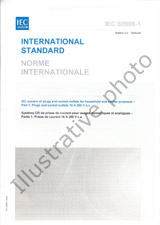We need your consent to use the individual data so that you can see information about your interests, among other things. Click "OK" to give your consent.

IEC 62002-2-ed.2.0
Mobile and portable DVB-T/H radio access - Part 2: Interface conformance testing
STANDARD published on 21.5.2008
The information about the standard:
Designation standards: IEC 62002-2-ed.2.0
Publication date standards: 21.5.2008
SKU: NS-414027
The number of pages: 103
Approximate weight : 340 g (0.75 lbs)
Country: International technical standard
Category: Technical standards IEC
The category - similar standards:
Annotation of standard text IEC 62002-2-ed.2.0 :
IEC 62002-2:2008 provides the conformance testing rules and guidelines for equipment built to meet the Mobile and portable DVB-T/H radio access interface specification (IEC 62002-1). One aim is to limit the number of tests to a practical level. Nevertheless, the manufacturer is responsible of guaranteeing that the terminal fulfils all aspects of the mobile and portable DVB-T/H radio access interface specification (IEC 62002-1). This second edition cancels and replaces the first edition, published in 2005 and constitutes a technical revision. The main changes with respect to the previous edition are. DVB-H has been included as a part of the main specification. All the performance figures have been revised as new simulation results have been made available as well as new reference receivers for DVB-H have been developed. DVB-H now includes all the different MPE-FEC code rates. New portable indoor and portable outdoor channel models have been included as well as performance figures for those. A new 2x TU-6 mobile SFN test channel has been included. A new L4 linearity pattern has been added. Dedicated performance figures for DVB-H for S1, S2, L1 to L4 interference patterns have been included. A new GSM-interference measurement method has been added. This bilingual version (2012-03) corresponds to the monolingual English version, published in 2008-05. La CEI 62002-2:2008 fournit les regles et les lignes directrices applicables aux essais de conformite des equipements construits pour satisfaire a la norme CEI 62002-1, acces radio mobile et portable en DVB-T/H. Elle vise notamment a limiter le nombre des essais a une valeur pratique. Il incombe neanmoins au fabricant de garantir que le terminal satisfait a tous les aspects de la specification de lacces radio mobile et portable en DVB-T/H (CEI 62002-1). Cette deuxieme edition annule et remplace la premiere edition, parue en 2005. Elle constitue une revision technique. Les principales modifications par rapport a ledition precedente sont: Le DVB-H a ete integre dans la specification principale. Tous les chiffres decrivant les performances ont ete revises pour tenir compte des nouveaux resultats de simulation et du developpement de nouveaux recepteurs de reference DVB-H. Le DVB-H inclut a present lensemble des differents debits du code MPE-FEC. De nouveaux types de canaux de propagation "portable en interieur" et "portable en exterieur" ont ete ajoutes ainsi que les performances chiffrees avec ces canaux. Un nouveau canal dessai SFN mobile 2x TU-6 a ete inclus. Un nouveau type de linearite L4 a ete ajoute. De nouveaux chiffres decrivant les performances particulieres du DVB-H pour les types dinterferences S1, S2, L1 a L4 ont ete integres. Une nouvelle methode de mesure des interferences GSM a ete ajoutee. La presente version bilingue (2012-03) correspond a la version anglaise monolingue publiee en 2008-05.
Similar standards:
18.5.2005
18.5.2005
15.12.2010
11.7.2011
11.3.2013
27.11.2012
We recommend:
Technical standards updating
Do you want to make sure you use only the valid technical standards?
We can offer you a solution which will provide you a monthly overview concerning the updating of standards which you use.
Would you like to know more? Look at this page.



 Cookies
Cookies
